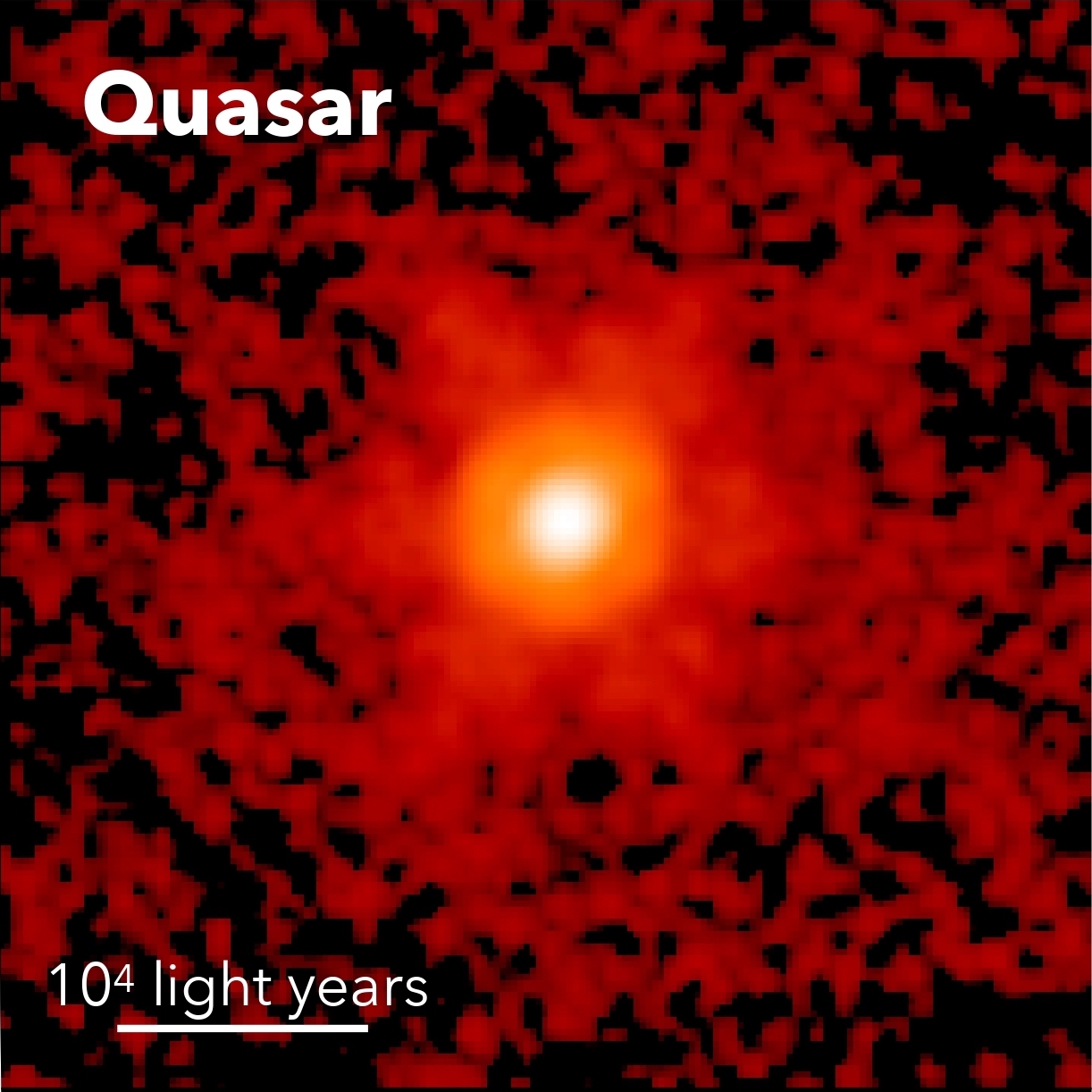Maunakea, Hawaiʻi – An international team of scientists, including Chien-Hsiu Lee, staff astronomer at W. M. Keck Observatory on Maunakea, Hawaiʻi Island, has captured images for the first time of starlight from two massive galaxies hosting actively growing black holes, or quasars, from less than a billion years after the Big Bang. The successful detection of these hosts represents the universe’s earliest epoch to date at which light from stars has been detected around a quasar.
These black holes have masses close to a billion times that of the Sun, and the ratio of the black hole mass to host galaxy mass is similar to those seen in the more recent universe. Initially discovered in a deep survey program of the Subaru Telescope on Maunakea, the two quasars were then captured by the James Webb Space Telescope (JWST). This powerful combination of ground-based observations from Subaru Telescope and space-based observations from JWST has paved a new path to study the distant universe.
The study, led by Kavli Institute for the Physics and Mathematics of the Universe (Kavli IPMU) Project Researcher Xuheng Ding and Professor John Silverman, and Peking University Kavli Institute for Astronomy and Astrophysics (PKU-KIAA) Kavli Astrophysics Fellow Masafusa Onoue, is published in today’s online issue of the journal Nature.
“This is the first time we’ve seen host galaxies from such an early age of the universe. It is only possible thanks to JWST’s deep images, which enable us to model and subtract the light from the quasar to reveal the host galaxy. We’ve seen quasars from this age previously, but they were so bright it was impossible to subtract their light to reveal the host galaxy,” says Lee, co-author of the study.

Studying host galaxies and black holes in the early universe allows scientists to watch their formation and see how they are related to one another. Quasars are luminous while their host galaxies are faint, which has made it challenging for researchers to detect the dim light of the galaxy in the glare of the quasar, especially at great distances. Before the JWST, the Hubble Space Telescope was able to detect host galaxies of luminous quasars when the universe was just under 3 billion years old, but no younger.
The superb sensitivity and ultra-sharp images of JWST at infrared wavelengths has finally allowed researchers to push these studies to the time when quasars and galaxies first formed. Just a few months after JWST started regular operations, the team observed two quasars, HSC J2236+0032 and HSC J2255+0251, at redshifts 6.40 and 6.34 when the universe was approximately 860 million years old, both of which were discovered using Subaru Telescope’s deep survey program. The relatively low luminosities of these quasars made them prime targets for measuring the properties of their host galaxies.
The images of the two quasars were taken at infrared wavelengths of 3.56 and 1.50 microns with JWST’s NIRCam instrument, and the host galaxies became apparent after carefully modeling and subtracting glare from the accreting black holes. The stellar signature of the host galaxy was also seen in a spectrum taken by JWST’s NIRSPEC for J2236+0032, further supporting the detection of the host galaxy.
Photometric analyses found that these two quasar host galaxies are massive, measuring 130 and 34 billion times the mass of the Sun, respectively. Measuring the speed of the turbulent gas in the vicinity of the quasars from the NIRSPEC spectra suggests the black holes that power them are also massive, measuring 1.4 and 0.2 billion times the mass of the Sun. The ratio of the black hole to host galaxy mass is similar to those of galaxies in the more recent past, suggesting that the relationship between black holes and their hosts was already in place 860 million years after the Big Bang.
“I’m excited to see powerful ground-based and space-based telescopes working together to tackle these challenges. Along with the Subaru Telescope, we will also be using Keck Observatory’s MOSFIRE instrument to identify similar targets that JWST can observe and enlarge the sample of ancient galaxies hosting quasars in the early universe,” says Lee.
The team of astronomers will continue this study using scheduled Cycle 1 JWST observations, which will further inform models for the coevolution of black holes and their host galaxies.
ABOUT THE MAUNAKEA OBSERVATORIES
The Maunakea Observatories are a collaborative of independent institutions with telescopes located on Maunakea on the island of Hawaiʻi. Together, the Observatories make Maunakea the most scientifically productive site for astronomy world-wide. The Maunakea Observatories include: Canada-France-Hawaii Telescope, international Gemini Observatory, a Program of NSFʻs NOIRLab, James Clerk Maxwell Telescope (EAO), NASA Infrared Telescope Facility, Subaru Telescope, Submillimeter Array, UKIRT Observatory, University of Hawai’i Hilo Educational Telescope, University of Hawai‘i 2.2 Meter Telescope, Very Long Baseline Array, and W. M. Keck Observatory (Keck I and Keck II).


